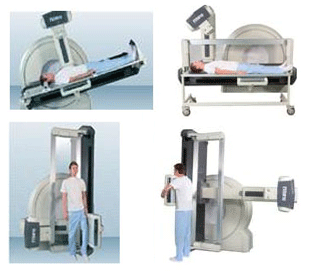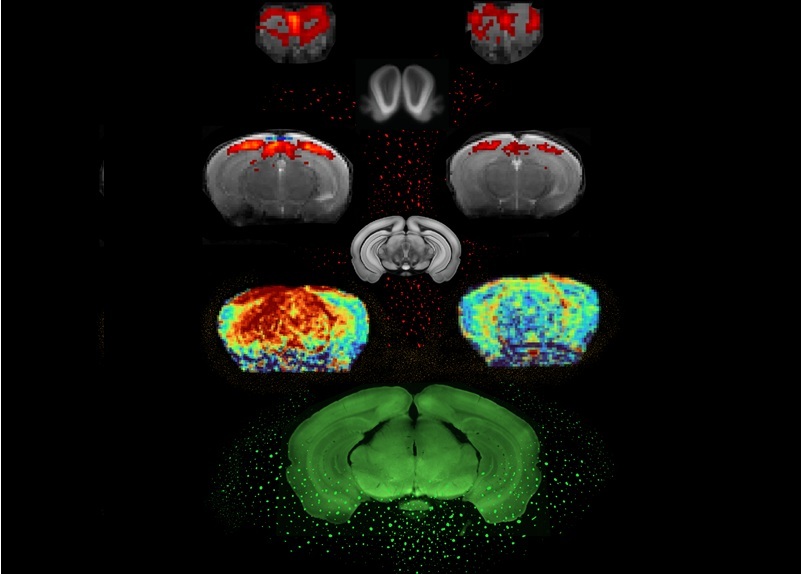Novel Tilting Table Performs All Radiography and Fluoroscopy Procedures on a Single System
|
By MedImaging International staff writers Posted on 13 Oct 2011 |

Image: The Clinodigit Omega (Photo courtesy of Italray).
A technologically advanced, new generation remote-controlled tilting table for radiography and fluoroscopy brings about workflow and cost optimization.
The Clinodigit Omega is the newest Italray (Florence, Italy) product, a next-generation device for both radiography and fluorography procedures that performs, in just one limited-size equipment, all the work of four different diagnostic rooms: digital fluoroscopy, emergency, radiography, and chest rooms.
The original design of the table has allowed procedures not as yet available on traditional radio-fluoro devices. The Clinodigit Omega differentiates itself because of two main characteristics: the tilting tabletop movement in which the patient table can be removed from the active X-ray area allows for more than the traditional dynamic examinations typical of remote-controlled tables--all the X-ray examinations require minimal patient-detector distance. It also performs radiography and fluoroscopy examinations directly on the mobile table for trauma patients that are too risky to move from mobile table to system tabletop, or for handicapped/elderly/bariatric patients who are difficult to move from mobile table to system tabletop.
Clinodigit Omega, according to company spokespersons, is the only one that can perform both fluoroscopy and radiography on a mobile table. The tube stand rise allows a focus film distance (FFD) source-image distance (SID) of 200 cm, once the table has been removed from the active area. This distance cannot be found in any other remote-controlled tilting table.
The well-established filmless technology has been improved by Italray with the Clinodigit Omega, introducing new standards in both digital radiography and fluorography, using, as an image acquisition system, a dynamic flat panel (amorphous silicon) for image display immediately after patient X-ray exposure. Once acquired, the image can be directly exported, (Digital Imaging and Communications in Medicine [DICOM]-format) to the information technology (IT) system in order to be visualized anywhere in the hospital network (other review stations), or to be sent to a DICOM printer, either exported on a read only device as CD/DVD for both an additional back up and to be delivered to patient.
“With Clinodigit Omega, we can now perform all X-ray examinations, both radiography and fluoroscopy, in one single room; this allowed us to switch from two dedicated rooms [one for radiography and one for fluoroscopy] to just one multipurpose room where all X-ray examinations can be performed with flexibility, patient comfort, and the excellent image quality given by the dynamic flat panel detector,” stated Dr. Andrea Stiatti, director of diagnostic imaging department, Leonardo da Vinci Institute (Florence, Italy).
“Rather than taking the old remote-controlled table architecture and just replacing the II [image intensifier] with the flat panel detector, like many vendors have done, with Clinodigit Omega we started completely from a blank sheet and designed a 100% new product, which, thanks to its unique features and functionalities, allows users to use the new dynamic flat panel detector at its full potential and without any legacy limitation,” said Filippo Recchi, export manager at Italray.
Related Links:
Italray
The Clinodigit Omega is the newest Italray (Florence, Italy) product, a next-generation device for both radiography and fluorography procedures that performs, in just one limited-size equipment, all the work of four different diagnostic rooms: digital fluoroscopy, emergency, radiography, and chest rooms.
The original design of the table has allowed procedures not as yet available on traditional radio-fluoro devices. The Clinodigit Omega differentiates itself because of two main characteristics: the tilting tabletop movement in which the patient table can be removed from the active X-ray area allows for more than the traditional dynamic examinations typical of remote-controlled tables--all the X-ray examinations require minimal patient-detector distance. It also performs radiography and fluoroscopy examinations directly on the mobile table for trauma patients that are too risky to move from mobile table to system tabletop, or for handicapped/elderly/bariatric patients who are difficult to move from mobile table to system tabletop.
Clinodigit Omega, according to company spokespersons, is the only one that can perform both fluoroscopy and radiography on a mobile table. The tube stand rise allows a focus film distance (FFD) source-image distance (SID) of 200 cm, once the table has been removed from the active area. This distance cannot be found in any other remote-controlled tilting table.
The well-established filmless technology has been improved by Italray with the Clinodigit Omega, introducing new standards in both digital radiography and fluorography, using, as an image acquisition system, a dynamic flat panel (amorphous silicon) for image display immediately after patient X-ray exposure. Once acquired, the image can be directly exported, (Digital Imaging and Communications in Medicine [DICOM]-format) to the information technology (IT) system in order to be visualized anywhere in the hospital network (other review stations), or to be sent to a DICOM printer, either exported on a read only device as CD/DVD for both an additional back up and to be delivered to patient.
“With Clinodigit Omega, we can now perform all X-ray examinations, both radiography and fluoroscopy, in one single room; this allowed us to switch from two dedicated rooms [one for radiography and one for fluoroscopy] to just one multipurpose room where all X-ray examinations can be performed with flexibility, patient comfort, and the excellent image quality given by the dynamic flat panel detector,” stated Dr. Andrea Stiatti, director of diagnostic imaging department, Leonardo da Vinci Institute (Florence, Italy).
“Rather than taking the old remote-controlled table architecture and just replacing the II [image intensifier] with the flat panel detector, like many vendors have done, with Clinodigit Omega we started completely from a blank sheet and designed a 100% new product, which, thanks to its unique features and functionalities, allows users to use the new dynamic flat panel detector at its full potential and without any legacy limitation,” said Filippo Recchi, export manager at Italray.
Related Links:
Italray
Latest Radiography News
- Machine Learning Algorithm Identifies Cardiovascular Risk from Routine Bone Density Scans
- AI Improves Early Detection of Interval Breast Cancers
- World's Largest Class Single Crystal Diamond Radiation Detector Opens New Possibilities for Diagnostic Imaging
- AI-Powered Imaging Technique Shows Promise in Evaluating Patients for PCI
- Higher Chest X-Ray Usage Catches Lung Cancer Earlier and Improves Survival
- AI-Powered Mammograms Predict Cardiovascular Risk
- Generative AI Model Significantly Reduces Chest X-Ray Reading Time
- AI-Powered Mammography Screening Boosts Cancer Detection in Single-Reader Settings
- Photon Counting Detectors Promise Fast Color X-Ray Images
- AI Can Flag Mammograms for Supplemental MRI
- 3D CT Imaging from Single X-Ray Projection Reduces Radiation Exposure
- AI Method Accurately Predicts Breast Cancer Risk by Analyzing Multiple Mammograms
- Printable Organic X-Ray Sensors Could Transform Treatment for Cancer Patients
- Highly Sensitive, Foldable Detector to Make X-Rays Safer
- Novel Breast Cancer Screening Technology Could Offer Superior Alternative to Mammogram
- Artificial Intelligence Accurately Predicts Breast Cancer Years Before Diagnosis
Channels
MRI
view channel
Simple Brain Scan Diagnoses Parkinson's Disease Years Before It Becomes Untreatable
Parkinson's disease (PD) remains a challenging condition to treat, with no known cure. Though therapies have improved over time, and ongoing research focuses on methods to slow or alter the disease’s progression,... Read more
Cutting-Edge MRI Technology to Revolutionize Diagnosis of Common Heart Problem
Aortic stenosis is a common and potentially life-threatening heart condition. It occurs when the aortic valve, which regulates blood flow from the heart to the rest of the body, becomes stiff and narrow.... Read moreUltrasound
view channel
New Incision-Free Technique Halts Growth of Debilitating Brain Lesions
Cerebral cavernous malformations (CCMs), also known as cavernomas, are abnormal clusters of blood vessels that can grow in the brain, spinal cord, or other parts of the body. While most cases remain asymptomatic,... Read more.jpeg)
AI-Powered Lung Ultrasound Outperforms Human Experts in Tuberculosis Diagnosis
Despite global declines in tuberculosis (TB) rates in previous years, the incidence of TB rose by 4.6% from 2020 to 2023. Early screening and rapid diagnosis are essential elements of the World Health... Read moreNuclear Medicine
view channel
Novel Radiolabeled Antibody Improves Diagnosis and Treatment of Solid Tumors
Interleukin-13 receptor α-2 (IL13Rα2) is a cell surface receptor commonly found in solid tumors such as glioblastoma, melanoma, and breast cancer. It is minimally expressed in normal tissues, making it... Read more
Novel PET Imaging Approach Offers Never-Before-Seen View of Neuroinflammation
COX-2, an enzyme that plays a key role in brain inflammation, can be significantly upregulated by inflammatory stimuli and neuroexcitation. Researchers suggest that COX-2 density in the brain could serve... Read moreGeneral/Advanced Imaging
view channel
AI-Based CT Scan Analysis Predicts Early-Stage Kidney Damage Due to Cancer Treatments
Radioligand therapy, a form of targeted nuclear medicine, has recently gained attention for its potential in treating specific types of tumors. However, one of the potential side effects of this therapy... Read more
CT-Based Deep Learning-Driven Tool to Enhance Liver Cancer Diagnosis
Medical imaging, such as computed tomography (CT) scans, plays a crucial role in oncology, offering essential data for cancer detection, treatment planning, and monitoring of response to therapies.... Read moreImaging IT
view channel
New Google Cloud Medical Imaging Suite Makes Imaging Healthcare Data More Accessible
Medical imaging is a critical tool used to diagnose patients, and there are billions of medical images scanned globally each year. Imaging data accounts for about 90% of all healthcare data1 and, until... Read more
Global AI in Medical Diagnostics Market to Be Driven by Demand for Image Recognition in Radiology
The global artificial intelligence (AI) in medical diagnostics market is expanding with early disease detection being one of its key applications and image recognition becoming a compelling consumer proposition... Read moreIndustry News
view channel
GE HealthCare and NVIDIA Collaboration to Reimagine Diagnostic Imaging
GE HealthCare (Chicago, IL, USA) has entered into a collaboration with NVIDIA (Santa Clara, CA, USA), expanding the existing relationship between the two companies to focus on pioneering innovation in... Read more
Patient-Specific 3D-Printed Phantoms Transform CT Imaging
New research has highlighted how anatomically precise, patient-specific 3D-printed phantoms are proving to be scalable, cost-effective, and efficient tools in the development of new CT scan algorithms... Read more
Siemens and Sectra Collaborate on Enhancing Radiology Workflows
Siemens Healthineers (Forchheim, Germany) and Sectra (Linköping, Sweden) have entered into a collaboration aimed at enhancing radiologists' diagnostic capabilities and, in turn, improving patient care... Read more





















